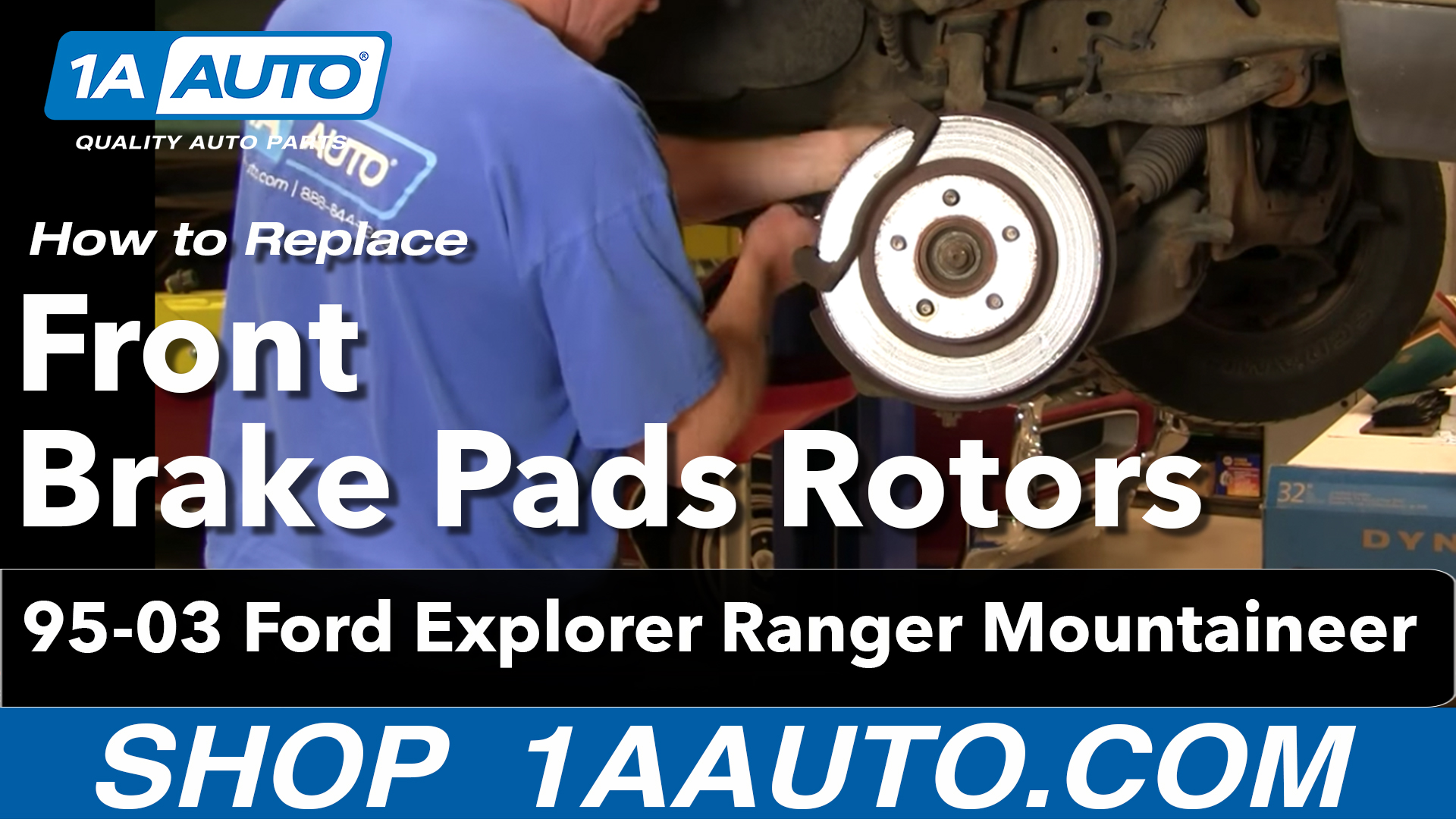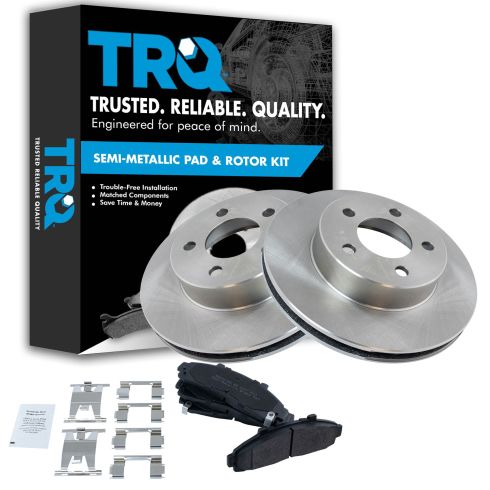
How to Replace Front Brakes 1995-2003 Ford Explorer
Created on: 2010-10-13
Check out this video to learn how to replace your old or worn front brakes in your 95-03 Ford Explorer.
-
step 1 :Remove the Wheel
- While your car is still on the ground, use your 21mm socket to loosen your lug nuts.
- Jack up and secure your car with jack stands.
- Remove the lug nuts with your 21mm socket and ratchet.
- Remove the wheel and set aside.
-
step 2 :Remove the calipers
- Remove the four 13mm bolts to remove the calipers.
- Use a wire tie to fasten the caliper out of the way.
- Use your screwdriver to pry out your brake pads.
- Use your 15mm socket and ratchet to remove your caliper brackets to access the rotors.
- Pull off the brake rotor.
-
step 3 :Install new rotor and pads
- Clean new rotor with brake cleaner.
- Check your caliper pins to make sure they are in good working order.
- Put your caliper bracket back on, and tighten the 15mm bolts to 60-65 ft lbs.
- Insert your new pads into the brackets.
- Dab the sides where they slide into the brackets with anti-seize lubricant.
- Loosen the cap on the brake fluid.
- Use your C-clamp or caliper tool to compress your caliper.
- Place your caliper onto the bracket.
- Tighten your 13mm bolts to 25 ft lbs
- Tighten the cap on your brake fluid.
-
step 4 :Put wheel back on
- Make sure to use a star pattern when putting your wheel lugs back on.
- Tighten to 100 ft lbs.
- Replace hubcap.
-
step 5 :Test and set brakes
- Before driving the car again, start it up and pump the brakes a few times to get the pistons in the brakes in place.
- Test the brakes in your driveway before taking the car onto the road.
- Set your rotors by evenly braking from 30mph to 10mph, 50mph-30mph and finally 70mph to 40mph.
- Obviously this is best done on a straight back road without any traffic.
Tools needed
-
21mm Socket
13mm Socket
Hammer
15mm Socket
Jack Stands
Anti-Seize Grease
Lug Wrench
Ratchet
Floor Jack
Brought to you by 1AAuto.com. Your source for quality replacement parts and the best service on the Internet.
Hi, I'm Mike Green. I'm one of the owners of 1A Auto. I want to help you save time and money repairing or maintaining your vehicle. I'm going to use my 20 plus year experience restoring and repairing cars and trucks like this to show you the correct way to install parts from 1aauto.com. the right parts installed correctly, that's going to save you time and money. Thank you and enjoy the video.
In this video, we'll be showing you how to remove and replace the front pads and rotors on this '98 Explorer, same as any 95 to 01 Explorer or Mountaineer and also the same as many front disk equipped vehicles. Tools you'll need are jack and jack stands, 13 mm, 15 mm, and 19 mm sockets and ratchet; hammer and punch or screwdriver, and that's only if one of your pads doesn't want to come out; and a large C-clamp.
Obviously, you're going to want to jack up and take care of your vehicle. You can just work a screwdriver under there and pry off your cap, and hen these are 19 mm. If you don't have impact tools loosen your lug nuts on the ground then raise your vehicle and secure it with the jackstand and then remove the lug nuts. Once the lug nuts are off, just pull the tire off. Once you have the wheel off, you see I've actually turned and you just pull on it, I've turned the wheels to the left. There're four bolts that basically hold the brakes on. There's one here, 13 mm, and one up here. Those just hold the calipers to this big bracket. There's also a 15 mm bolt here and a 15 mm bolt right up here. Those hold the bracket to the steering knuckle. The larger bolts allow you to get your rotor off while these smaller ones just allow you to get your caliper off.
I'll remove the two smaller ones first. Top one, I can't get my impact wrench in there, so do it the old fashioned way. You can see when I did that my caliper popped right off which means my bolt might be stuck in here. Take my other bolt off. Now my caliper can come right up and off. Just put that right up here. You can see here I just wire tied my caliper up here to keep in place. We're just looking to change your pads. You just pull them off right here. They pull right out. I'm just going to use a punch and a little hammer to tap my rear pad out there. Actually, these pads are in pretty good shape. You remove the two larger 15 mm bolts. This bracket then comes right off and your rotor comes right off. You can see the new rotor's on there. It fits nicely. Obviously, everything in the kit from 1A Auto's going to fit well. This truck is just a video mule and the brakes are actually fine on it, so I am just going to reinstall the original brakes. I just wanted to show you that. You may have noticed from the wonders of editing there is a new hub on there, so you can see our video for hub installation. Truck did need a new hub. Obviously, the rotor goes right on. You want to put the hub bracket back on which bolts into the back here. The bracket does go on the hub side of the steering knuckle. These bolts, they're the 15 mm that hold this bracket on. You want to tighten to about 60 to 65 foot pounds.
The new pads from 1A Auto, you can see these are the pads that are on the truck. They actually have life left. Here's the metal. This is the metal of the pad, and then here's the pads themselves, so there's still some pretty good wear. You can see the new ones are quite a bit thicker. Just want to show our pads will install just like the original. What you might need to do for this application, these wear tabs may get in your way, so you may need to just use a hammer and tap them down. You can see on this it's tapped down, so it's facing straight down that's because it has to go into the bracket. What I might suggest is before you put the pads on, just is this just a little bit of anti-seize. You can use any kind of lubricant, maybe a little bit of white grease. I'm just going to put this in where the pads go in. Be careful not to get it on the disc. You don't want to get anything on your rotor that would interfere with the friction of the brake pads. This right here is where the pads install into, so I just put a little bit of lubricant on it and on the backside as well. It doesn't when you put the new pads in which side you put them in. I'm going to put these back the way they were. This one was on the front side. Like I said, with new ones it doesn't really matter how you put them in, but these were already installed so leave them on the way they were installed. This back one is going to require a little bit of tapping.
You're going to want to loosen up the cap on your brake fluid here. If you're putting new pads on you'll want to take a C-clamp like this and you're going to want to push your pistons back into the caliper. Even in fast motion you can see here the clamp just pushes the piston in, and you want to be careful that you don't pinch any lines or anything like that. If your calipers have more than one piston you have to do it on all pistons.
Now these bolts only require about 30 foot pounds of torque, so I'm just using this wrench and getting them tight but no incredibly tight. They just hold the caliper. What it actually does the braking is this big bracket here that's bolted to the steering knuckle. The caliper pushes the pad against the rotor, and then that pad jams up against this bracket. This bracket is tightened on with 65 to 70 foot pounds while these bolts only will be about 20 or 30 foot pounds because they're just holding the caliper in place.
Just a quick word here, when you go to test drive your car, first thing you want to do is pump your brakes a bunch of times. As you push those pistons back in they need to work their way back out, so you want to pump your brakes a bunch of times, and then you'll want to hold your brake, put it in gear, and make sure the brakes hold the car, and then do a 10 mile an hour stop and just make sure your brakes are working before you put it on the road and road test it.
Now just in the interest of keeping it short, we'll put the wheel back on, put your lug nuts on, get them snug, then lower the car to the ground, torque them up to 90 to 100 foot pounds, replace your cap and you're in business.
We hope this helps you out. Brought to you by www.1AAuto.com, your source for quality replacement parts and the best service on the Internet. Please feel free to call us toll free, 888-844-3393. We're the company that's here for you on the Internet and in person.

Ford Mazda Mercury Front Semi-Metallic Brake Pad & Rotor Kit TRQ BKA10488
Part Details:
- Premium Posi
- Semi-Metallic
- (2) Front Brake Rotors
- (1) Front Semi-Metallic Brake Pad Set

How To Replace Front Brakes 2000-04 Ford Focus
Check out this video and learn how to do your own brakes! This one is for your 00-04 Ford Focus. You can do it, 1A Auto will help!

